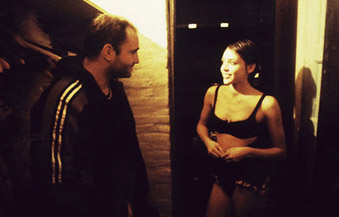|
|
Chapter TwoPusher IIBy Brett Ballard-BeachOctober 13, 2011
I am not precisely sure when this tipping point occurred. Having a child now is a contributing factor, but was by no means the instigator. In an odd way, it recalls for me when my parents took me to see my first R-rated film, Blue Thunder, in the theaters. Although I remember little of the plot from nearly 30 years ago, I recall distinctly the scene where Roy Scheider’s partner escapes from the bad guys and they shoot him in the back as he is running down the street. My seven-year-old-mind thought, “But, but, they can’t do that. He couldn’t defend himself.” Now that I am becoming less, not more, inured to displays of violence, it has become common practice for me to squeal, recoil, or shout an audible, “Ohhhh, FUCK!” at scenes such as John Malkovich’s attack on Richard Jenkins in Burn After Reading (even though this is in long shot, with no blood), Daniel Plainview’s improper use of a bowling pin in There Will Be Blood, or the ultimate fate of the gymnast in Final Destination 5. The Pusher films are about many things, including the buildup of tremendous unease that sooner or later (generally the latter) ends in violence, but release from tension is not one of them. The first film ends at what appears to be the bottom of a downward spiral, but there is no relief even then. The entire film is really an exercise in suspension, in allowing its protagonist to dig himself deeper and deeper into a financial and moral quagmire, always finding out, to his surprise and ours, that the hole has no bottom. Shot in chronological order, with a handheld camera that helps maintain a rough immediacy and an air of dread from start to finish, Pusher is intense but also contains a thicket of odd humor.
|

|
|
|

|
Friday, November 1, 2024
© 2024 Box Office Prophets, a division of One Of Us, Inc.


